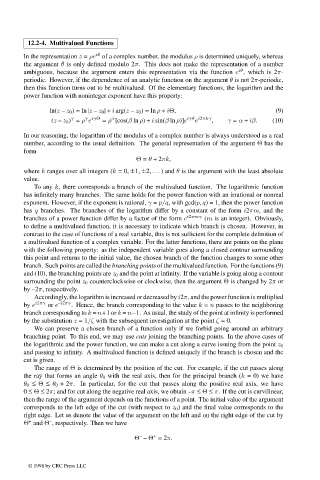Page 618 - Handbook Of Integral Equations
P. 618
12.2-4. Multivalued Functions
iθ
In the representation z = ρe of a complex number, the modulus ρ is determined uniquely, whereas
the argument θ is only defined modulo 2π. This does not make the representation of a number
iθ
ambiguous, because the argument enters this representation via the function e , which is 2π-
periodic. However, if the dependence of an analytic function on the argument θ is not 2π-periodic,
then this function turns out to be multivalued. Of the elementary functions, the logarithm and the
power function with noninteger exponent have this property:
ln(z – z 0 )=ln |z – z 0 | + i arg(z – z 0 )=ln ρ + iΘ, (9)
α
γ
γ iγΘ
e
(z – z 0 ) = ρ e = ρ [cos(β ln ρ)+ i sin(β ln ρ)]e iγθ i2πkγ , γ = α + iβ. (10)
In our reasoning, the logarithm of the modulus of a complex number is always understood as a real
number, according to the usual definition. The general representation of the argument Θ has the
form
Θ = θ +2πk,
where k ranges over all integers (k =0, ±1, ±2, ... ) and θ is the argument with the least absolute
value.
To any k, there corresponds a branch of the multivalued function. The logarithmic function
has infinitely many branches. The same holds for the power function with an irrational or nonreal
exponent. However, if the exponent is rational, γ = p/q, with gcd(p, q) = 1, then the power function
has q branches. The branches of the logarithm differ by a constant of the form i2πm, and the
branches of a power function differ by a factor of the form e i2πmγ (m is an integer). Obviously,
to define a multivalued function, it is necessary to indicate which branch is chosen. However, in
contrast to the case of functions of a real variable, this is not sufficient for the complete definition of
a multivalued function of a complex variable. For the latter functions, there are points on the plane
with the following property: as the independent variable goes along a closed contour surrounding
this point and returns to the initial value, the chosen branch of the function changes to some other
branch. Such points are called the branching points of the multivalued function. For the functions (9)
and (10), the branching points are z 0 and the point at infinity. If the variable is going along a contour
surrounding the point z 0 counterclockwise or clockwise, then the argument Θ is changed by 2π or
by –2π, respectively.
Accordingly, the logarithm is increased or decreased by i2π, and the power function is multiplied
by e i2πγ or e –i2πγ . Hence, the branch corresponding to the value k = n passes to the neighboring
branch corresponding to k = n+1 or k = n–1. As usual, the study of the point at infinity is performed
by the substitution z =1/ζ with the subsequent investigation at the point ζ =0.
We can preserve a chosen branch of a function only if we forbid going around an arbitrary
branching point. To this end, we may use cuts joining the branching points. In the above cases of
the logarithmic and the power function, we can make a cut along a curve issuing from the point z 0
and passing to infinity. A multivalued function is defined uniquely if the branch is chosen and the
cut is given.
The range of Θ is determined by the position of the cut. For example, if the cut passes along
the ray that forms an angle θ 0 with the real axis, then for the principal branch (k =0) we have
θ 0 ≤ Θ ≤ θ 0 +2π. In particular, for the cut that passes along the positive real axis, we have
0 ≤ Θ ≤ 2π; and for cut along the negative real axis, we obtain –π ≤ Θ ≤ π. If the cut is curvilinear,
then the range of the argument depends on the functions of a point. The initial value of the argument
corresponds to the left edge of the cut (with respect to z 0 ) and the final value corresponds to the
right edge. Let us denote the value of the argument on the left and on the right edge of the cut by
+
–
Θ and Θ , respectively. Then we have
–
+
Θ – Θ =2π.
© 1998 by CRC Press LLC
© 1998 by CRC Press LLC
Page 601

